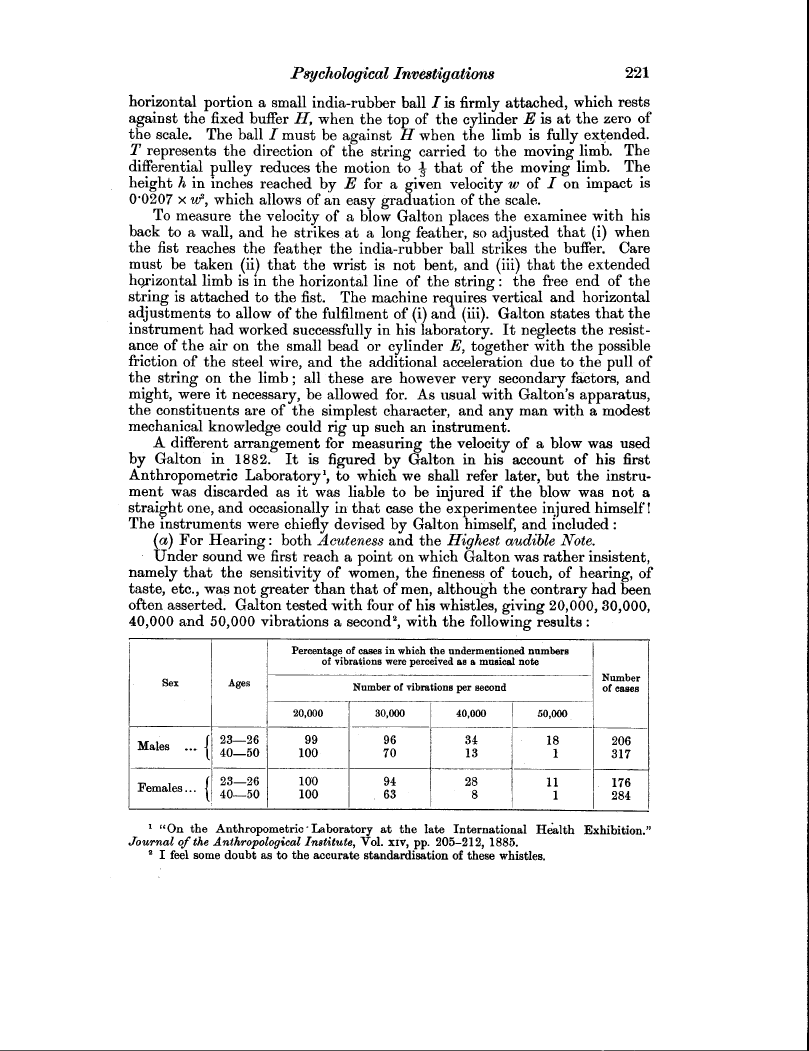Psychological Investigations 221
horizontal portion a small india-rubber ball I is firmly attached, which rests against the fixed buffer H, when the top of the cylinder E is at the zero of the scale. The ball I must be against H when the limb is fully extended. T represents the direction of the string carried to the moving limb. The differential pulley reduces the motion to 3 that of the moving limb. The height h in inches reached by E for a given velocity w of I on impact is 0.0207 x w2, which allows of an easy graduation of the scale.
To measure the velocity of a blow Galton places the examinee with his back to a wall, and he strikes at a long feather, so adjusted that (i) when the fist reaches the feather the india-rubber ball strikes the buffer. Care must be taken (ii) that the wrist is not bent, and (iii) that the extended horizontal limb is in the horizontal line of the string : the free end of the string is attached to the fist. The machine requires vertical and horizontal adjustments to allow of the fulfilment of (i) and (iii). Galton states that the instrument had worked successfully in his laboratory. It neglects the resistance of the air on the small bead or cylinder E, together with the possible friction of the steel wire, and the additional acceleration due to the pull of the string on the limb ; all these are however very secondary factors, and might, were it necessary, be allowed for. As usual with Galton's apparatus, the constituents are of the simplest character, and any man with a modest mechanical knowledge could rig up such an instrument.
A different arrangement for measuring the velocity of a blow was used by Galton in 1882. It is figured by Galton in his account of his first Anthropometric Laboratory', to which we shall refer later, but the instrument was discarded as it was liable to be injured if the blow was not a straight one, and occasionally in that case the experimentee injured himself The instruments were chiefly devised by Galton himself, and included
(a) For Hearing : both Acuteness and the Highest audible Note.
Under sound we first reach a point on which Galton was rather insistent, namely that the sensitivity of women, the fineness of touch, of hearing, of taste, etc., was not greater than that of men, although the contrary had been often asserted. Galton tested with four of his whistles, giving 20,000, 30,000, 40,000 and 50,000 vibrations a second2, with the following results
| |
|
Percentage of cases in which the undermentioned numbers
of vibrations were perceived as a musical note |
|
|
Sex |
Ages |
Number of vibrations per second |
Number
of cases |
| |
|
20,000 |
30,000 |
40,000 |
50,000 |
|
|
Males |
23-26 |
99 |
96 |
34 |
18 |
206 |
| |
40-50 |
100 |
70 |
13 |
1 |
317 |
|
Females |
23-26 |
100 |
94 |
28 |
11 |
176 |
|
... |
40-50 |
100 |
63 |
8 |
1 |
284 |
1 "On the Anthropometric -Laboratory at the late International Health Exhibition." Journal of the Anthropological Institute, Vol. xiv, pp. 205-212, 1885. 2 1 feel some doubt as to the accurate standardisation of these whistles.

